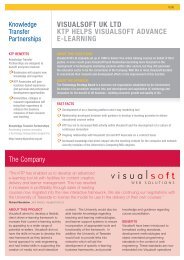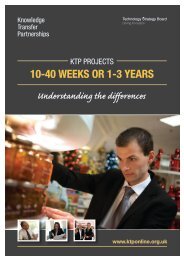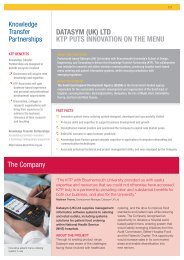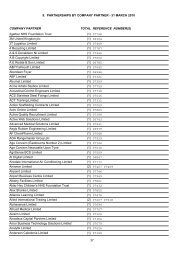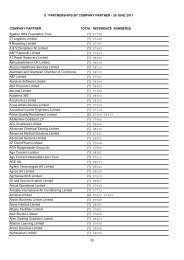Achievements and Outcomes - Knowledge Transfer Partnerships
Achievements and Outcomes - Knowledge Transfer Partnerships
Achievements and Outcomes - Knowledge Transfer Partnerships
Create successful ePaper yourself
Turn your PDF publications into a flip-book with our unique Google optimized e-Paper software.
<strong>Knowledge</strong> <strong>Transfer</strong> <strong>Partnerships</strong><br />
The split for classic KTP projects remains<br />
consistent with 2010-11, with large organisations<br />
accounting for around one third of the portfolio.<br />
Of projects involving large organisations,<br />
86% are with private sector companies.<br />
Projects by company size<br />
Information on the overall portfolio of KTP<br />
projects (defined by number of associate<br />
places) at the end of the year by size of<br />
business enterprise is given in figure 4,<br />
including both classic <strong>and</strong> shorter KTP<br />
projects. KTP projects continue to average<br />
around 26 months in duration, consistent<br />
with previous years.<br />
The majority of shorter KTPs continue<br />
to be with micro or small enterprises,<br />
accounting for 63% of the total number<br />
of shorter KTPs. This compares with 45%<br />
for classic KTPs. The difference is most<br />
marked for micro businesses, which have<br />
taken part in nearly one-third of the shorter<br />
KTPs compared to only 10% of classic<br />
KTPs. This is consistent with the aims<br />
of the shorter KTP scheme, which was<br />
implemented after the ‘Sainsbury Review’ to<br />
provide an opportunity for businesses who<br />
may not otherwise have the resources or<br />
capability to manage a larger KTP project.<br />
Micro businesses have consistently<br />
accounted for 8-10% of the classic KTP<br />
portfolio over the last five years, reflecting<br />
the programme’s ongoing commitment to<br />
attracting innovative, early stage companies<br />
into the scheme when possible.<br />
<strong>Partnerships</strong> by sector <strong>and</strong><br />
primary business function<br />
Figure 5 provides a current breakdown<br />
of the portfolio by industry sector.<br />
Whilst the numbers of partnerships<br />
has decreased compared to previous<br />
years, the percentages have remained<br />
relatively stable across most sectors.<br />
The biggest change was in the service<br />
industry sector (including distribution),<br />
which has fallen from 21% in March 2011<br />
to 15% in March 2012.<br />
Figure 6 gives a breakdown of the<br />
types of business functions in which<br />
KTP projects have been undertaken.<br />
The biggest changes from the previous<br />
year are an increase in the percentage of<br />
projects in the research <strong>and</strong> development<br />
function (up from 22% to 31%), which<br />
is good news in a difficult economic<br />
environment. However, there was a<br />
reduction in projects in product design<br />
<strong>and</strong> development (from 28% to 23%),<br />
again, possibly reflecting current wider<br />
economical trends. It should be noted<br />
that this information reflects the functions<br />
in which the projects are based, not<br />
necessarily what the project is about.<br />
Figure 4: Total number of KTP projects by size of enterprise (March 2012)<br />
Micro-businesses Small enterprises Medium-sized Large enterprises Total<br />
(under 10 (10 – 49 enterprises (250 or more<br />
employees) employees) (50 –249 employees) employees)<br />
Year 10-11 11-12 10-11 11-12 10-11 11-12 10-11 11-12 10-11 11-12<br />
Number of 99 86 391 294 263 197 330 268 1,083 845<br />
classic KTP<br />
projects<br />
Proportion 9% 10% 36% 35% 24% 23% 31% 32% 100% 100%<br />
of portfolio<br />
Number of 97 120 126 139 71 77 70 77 364 413<br />
shorter KTP<br />
projects*<br />
Proportion 27% 29% 35% 34% 19% 19% 19% 19% 100% 100%<br />
of portfolio*<br />
* The number of shorter partnerships at the end of<br />
2011-12 represents all 413 supported projects -<br />
not just those in the current portfolio as expressed<br />
by the annual rolling number. The ‘proportion of the<br />
portfolio’ is also based on this figure.<br />
10 | Technology Strategy Board



